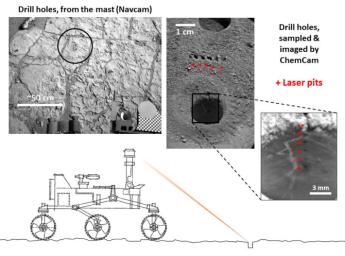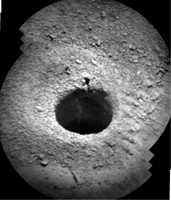
|
Accurate Pointing by Curiosity
- Click the image above for a larger view
- Full-Res JPEG (910 x 675) (105.0 kB)
- Full-Res TIFF (910 x 675) (1.8 MB)
Caption:

Figure 1
Click on the image for larger version
NASA's Curiosity Mars rover targeted the laser of the Chemistry and Camera (ChemCam) instrument with remarkable accuracy for assessing the composition of the wall of a drilled hole and tailings that resulted from the drilling. This graphic diagrams the pointing and shows the resulting pits created by the laser shots.
On the 180th Martian day, or sol, of Curiosity's work on Mars (Feb. 6, 2013), the rover performed a "mini drill test," followed on Sol 182 (Feb. 8, 2013) by the actual drilling to collect a sample from the interior of the rock. Both holes in the target rock "John Klein" are visible in the image at upper left, taken on Sol 182 by the rover's Navigation Camera (Navcam). Both the Navcam and the ChemCam are at the top of the Curiosity's remote-sensing mast.
Each drilled hole is about 0.63 inch (1.6 centimeters) wide, and they are located about 8 feet (about 2.5 meters) away from the top of the mast. So small, so far away...
On Sol 227 (March 26, 2013), ChemCam fired its laser 150 times (5 bursts of 30 shots, each burst at a different target point) on the drill tailings between the two holes and 300 times (10 bursts of 30 shots) in the drill hole itself. The same day, ChemCam's remote micro-imager (RMI) captured images of the laser pits: small craters in the loose tailing (center photo from RMI), and tiny scrapes on the hard surface of the hole walls (photo at right from RMI). Composition spectra from the ChemCam laser inspection are under investigation.
Figure 1 is a composite of RMI images of the drilled hole. The photo on the right of the main image is a brightened version of the center portion of Figure 1.
Background Info:
ChemCam was developed, built and tested by the U.S. Department of Energy's Los Alamos National Laboratory in partnership with scientists and engineers funded by France's national space agency, Centre National d'Etudes Spatiales (CNES) and research agency, Centre National de la Recherche Scientifique (CNRS).
NASA's Jet Propulsion Laboratory, a division of the California Institute of Technology, Pasadena, manages the Mars Science Laboratory Project, including Curiosity, for NASA's Science Mission Directorate, Washington. JPL designed and built the rover.
More information about Curiosity is online at http://www.nasa.gov/msl and http://mars.jpl.nasa.gov/msl/ .
Cataloging Keywords:
| Name | Value | Additional Values |
|---|---|---|
| Target | Mars | |
| System | ||
| Target Type | Planet | |
| Mission | Mars Science Laboratory (MSL) | |
| Instrument Host | Curiosity Rover | |
| Host Type | Rover | |
| Instrument | Chemistry & Camera (ChemCam) | Navigation Camera (Navcam) |
| Detector | ||
| Extra Keywords | Color, Crater | |
| Acquisition Date | ||
| Release Date | 2013-04-12 | |
| Date in Caption | 2013-02-06 | 2013-02-08, 2013-03-26 |
| Image Credit | NASA/JPL-Caltech/LANL/CNES/IRAP/LPGNantes/CNRS/IAS | |
| Source | photojournal.jpl.nasa.gov/catalog/PIA16922 | |
| Identifier | PIA16922 | |
